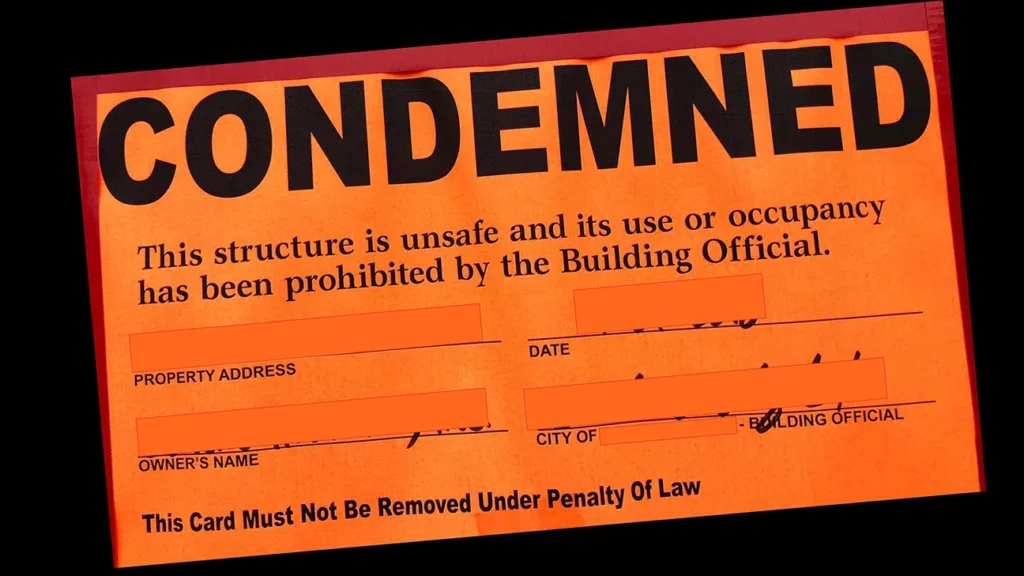
When a property in Bakersfield, California is condemned or “Red Tagged”, it can create a complex and stressful situation for homeowners, particularly when a mortgage is still in place. Understanding what happens to the mortgage on a condemned property is crucial for making informed decisions. In this blog, we’ll explore the implications of a property being condemned, how it affects your mortgage, and the options available to homeowners in this challenging scenario.
Understanding Red-Tagged Status
A property receives condemned status or becomes “Red Tagged” when local authorities determine it’s uninhabitable due to critical safety concerns, structural deficiencies, or significant building code violations. This official designation prohibits any occupancy until the property undergoes necessary repairs, meets current safety standards and in some cases current building codes, and successfully passes re-inspection, and all fines and fees are paid or an arraignment is made to pay them. Condemnation typically occurs following prolonged neglect, weather-related catastrophes, fire damage, substantial structural compromises, or other health or safety issues like major mold vermin infestation.
What Happens to Your Mortgage When Your Bakersfield Property Is Condemned?
When your Bakersfield, CA property is condemned, the mortgage on the property doesn’t simply disappear. Here’s what you need to know:
- Your Mortgage Obligation Continues
When your property receives a condemnation notice, your mortgage responsibility doesn’t disappear. You remain legally bound to make all scheduled payments on time. Missing these payments could trigger foreclosure proceedings and affect your credit, adding another layer of stress and financial hardship to your already challenging situation. - Property Value and Mortgage Balance
Condemnation typically causes the property’s value to plummet, sometimes to less than what is owed on the mortgage, however the mortgage balance will not change because of habitably status. - Insurance Considerations
Before proceeding, thoroughly review your homeowners’ insurance policy to determine if it covers the specific damages that resulted in condemnation. While some policies may cover partial repair costs or provide compensation for your loss, damages stemming from neglect or progressive deterioration typically face limited coverage or outright denial. Schedule a consultation with your insurance representative to fully understand your coverage options. Remember that failing to address these identified issues promptly could result in complete termination of your insurance coverage, creating even greater financial exposure.
Options for Homeowners with a Condemned Property and a Mortgage
- Make Necessary Repairs
One option is to repair the property to bring it up to code and remove the condemnation status. This can be a costly and time-consuming process, but it may be necessary to preserve the property’s value and avoid further financial complications. Once the repairs are completed and the property passes inspection, you can continue living in the home or sell it to pay off the mortgage. - Sell the Property As-Is
If you’re unable or unwilling to make the repairs, selling the property as-is to a real estate investor or direct buyer like Quick Home Offers® can be a viable solution. Direct buyers specialize in purchasing distressed properties, including those that are condemned. This allows you to sell the property quickly without making repairs, and the proceeds can be used to pay off or reduce your mortgage balance. Remember that the sale price may be lower due to the property’s condition. - Negotiate a Short Sale
In cases where the mortgage balance exceeds the property’s value, you might consider negotiating a short sale with your lender. A short sale occurs when the lender agrees to accept less than the full amount owed on the mortgage. This option can help you avoid foreclosure, but it requires lender approval and can be a lengthy process. Be prepared to provide documentation showing that you cannot continue making payments and that the property’s value has declined due to condemnation. - Deed in Lieu of Foreclosure
Another option is a deed in lieu of foreclosure, where you voluntarily transfer property ownership to the lender to satisfy the mortgage debt. This process can be less damaging to your credit than foreclosure and allows you to walk away from the mortgage. However, not all lenders will agree to this option, which may require you to demonstrate that you have exhausted other alternatives. - Foreclosure
When you’re unable to maintain mortgage payments and have exhausted other options, your lender may begin foreclosure proceedings. This legal process allows the lender to take ownership of your property due to payment default. The consequences of foreclosure are significant, including substantial credit damage and the potential loss of all your accumulated home equity. Given these serious impacts, foreclosure should only be considered after exploring all other alternatives.
Dealing with a condemned property while still carrying a mortgage can be overwhelming. The key is to act quickly and explore all available options to minimize financial damage and protect your interests.
If you are in this situation, Quick Home Offers® is here to help. We specialize in purchasing properties in any condition, including those that have been condemned. By selling your property to us directly, you can avoid the stress of making repairs, negotiating with lenders, and the potential for foreclosure. Contact us today to learn more about how we can assist you in resolving your mortgage issues and moving forward with peace of mind.

